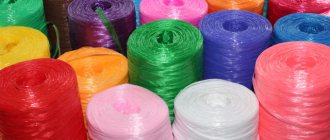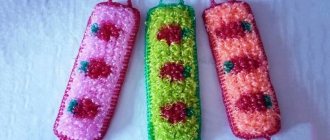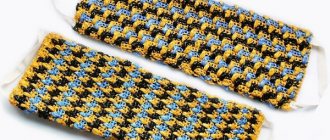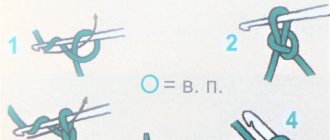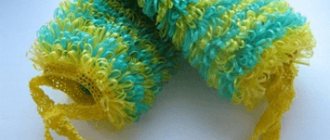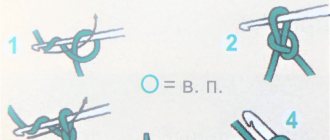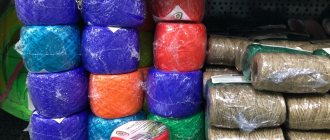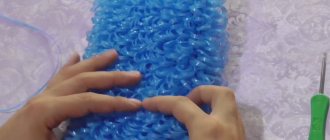Types of washcloths
Based on shape and style, the following types can be distinguished:
- flat or tubular, with or without handles, shaggy or dense;
- kolobok, also known as a ball or “monkey fist”;
- mitten or mitten;
- the brick, however, can be a heart, a voluminous pad of any shape, convenient for holding in the hand;
- fine mesh net;
- a separate class is soap-washcloth made of felt or wool.
The diversity is due to the wide range of applications and personal preferences. One rubs the back, the other massages the face, the third helps fight cellulite.
Crochet washcloth video tutorials
Crocheted washcloth toy “Clean Bear” with elongated loops
The toy has eyes, a nose and ears. On one side it is shaggy, and on the other side it is smooth and has a comfortable handle.
To knit a washcloth you will need:
- polypropylene threads of three colors: any main color, black and white for the eyes
- scissors
- needle
- hook No. 2.5, hard so as not to bend
Part 1 The video should load here, please wait or refresh the page.
Part 2 The video should load here, please wait or refresh the page.
What kind of yarn is there?
The technique of knitting washcloths is simple. Women who know how to hold a hook and knitting needles will do it easily. There is also a method of knot weaving, close to macrame. If the size and style are chosen, then the next step is to decide on the material. And then your eyes widen, what kind of yarn does not exist! Take natural fibers:
- Jute is a textile fiber, material for twine and burlap. The strands are hard, good material for washcloths.
- Manila fiber from abaca (spinning banana).
- Hemp is the fiber from the stems of hemp.
- Bast is a deep layer of linden or willow bark, a wonderful material that releases phytoncides beneficial to health, but unfortunately it is short-lived.
- Loofah - “loofah gourd” or “crazy cucumber”, the dried and peeled core itself is a ready-made loofah, but if you are not satisfied with the shape, you can comb out the fiber for spinning.
- Sisal is a coarse agave fiber, a guest from South America.
- Ramie is a Chinese nettle, our Russian one is no worse, you just need to squeeze the stems correctly, dry them and fluff them into fibers. Enthusiasts do the same with rhubarb petioles.
- Cotton yarn is a wonderful material, but not very practical for washcloths.
- Flax, flax fiber is a product of processing flax straw.
- Wool is an excellent yarn for washcloths, the coarser the better.
- Steel is most often found in the form of lace wire scourers or twisted springy strips, and is primarily used for cleaning utensils.
- Exotic materials such as birch bark and stone wool (granite, basalt).
Natural materials are good for everyone, but in addition to fragility, there are other disadvantages: rarity on the Russian market and, accordingly, high cost (with the exception of jute and flax), a narrow range of threads and yarn. They are susceptible to rotting and mold, and colonies of pathogenic microorganisms easily develop on them. This means that additional efforts are required for disinfection, washing, and drying.
What can you connect?
Propylene threads are suitable for knitting:
- washcloths;
- napkins;
- bags;
- rugs
You need to choose the thickness of the threads depending on the density of the finished product you want to obtain.
Bag
Propylene thread will make a great bag for the beach or shopping. The advantages of such a product are obvious - they do not get very dirty, since the dirt does not eat into the fiber itself .
And if the bag does get dirty, then washing it is very simple and, moreover, after this procedure it does not change its characteristics. In order to knit a medium-sized bag, you will need about 800 m - which is 4 skeins of 50 grams. thread The most important thing when starting work is to decide on the dimensions of the bag.
Choose a hook for the bag that is ½ size thinner than recommended on the skein of thread. This will help create a product that is denser and will not stretch under the weight of what will be inside.
It is important to understand what the length, thickness and height of the finished product will be. The bottom will determine the length and thickness of the bag. In order to get started, you need to knit a series of loops to the desired length. Then:
- Knit sequential rows in columns, best without crochets to the depth of the product.
- After this, tie the bottom with loops and continue knitting in the round to the desired height, that is, to the height of the bag. You can knit either with single crochets or with 1 or 2 crochets or any other patterns.
- After the bag itself is finished, you should knit the handles of the product and sew them to the bag. The number of options for a bag can be endless, since you can combine different colors and make different patterns. But the approximate diagram of a crocheted bag made of propylene threads looks like the one shown in the figure.
washcloth
For a washcloth, you need to take a propylene thread of a color so that it harmonizes with the overall interior of the bathroom.
For adults, you can take a thicker thread, while for a children's washcloth it is better to choose a thinner thread, it will be more gentle on children's skin. Before starting work, soak the threads in boiling water for about 5 minutes. This will make them softer and more obedient. First you need to decide what the washcloth will look like. There are two model options:
- Knitted as a flat oval piece with a loop attached.
- In the form of a pipe with loops attached to the ends for ease of use.
For a flat model, you must first determine the size of the washcloth and then crochet the number of loops along the length of the product . Knit one row alternately with simple stitches, while in the second row make elongated loops.
If a pipe washcloth is knitted, it is done according to this pattern. But it is worth considering that it is approximate, since the dimensions can be changed and also depend on the thickness of the threads.
Rug
A rug made of propylene threads will look great in the bathroom.
This product is easy to maintain and care for because it does not get dirty, is easy to wash, does not absorb excess moisture and does not accumulate it. To make such a product with your own hands using a crochet hook, it is enough to determine the overall dimensions - length and width . Then cast on either the length or width of the appropriate number of loops and knit until the desired size is obtained. The rug is knitted in single crochets in odd rows , while chain stitches are knitted in even rows. You can knit air loops in every third row, so the rug will not be too fluffy.
After the product is finished, the loops can be left as they were. Or you can cut each loop in half with scissors at the top point, so the carpet will not have a loop structure, but a thread structure.
DIY vase made of thread and glue
Satin ribbon star
Synthetic materials
Seeing the disadvantages of natural materials, consumers often opt for synthetic ones, such as:
- Nylon and nylon - both threads and yarn are available in a wide range, most often in the form of an additive to wool. Craftsmen use pantyhose, stockings, and any fabrics suitable for secondary use for washcloths, cut into narrow strips.
- Polyethylene is an industrially produced yarn, but folk craftsmen make their own by using used plastic bags.
- Viscose is an artificial fiber made from pine or bamboo wood.
- Acrylic is a synthetic polymer fiber.
- Polypropylene is a synthetic thermoplastic non-polar polymer belonging to the class of polyolefins. The king of knitting and needlework. Excellent yarn for washcloths.
- Rubber - natural and artificial, is commonly known as a rubber sponge, but modern technology makes it possible to create rubber yarn. True, it is not available for sale in its pure form.
Synthetic materials do not rot, and their service life is many times longer than natural ones. They are easy to wash and dry quickly. In the form of washcloths, they lather well and perfectly cleanse the skin of fat and sweat, dirt and dead particles. Synthetic fibers come in varying degrees of stiffness, which makes it possible to knit a loofah for any skin.
Polypropylene yarn
Polypropylene fibers and threads are characterized by increased strength. Accordingly, yarn for washcloths made of polypropylene is a very convenient material for needlework. Absolutely not afraid of moisture and mechanical impact. Has high wear resistance
There are 100% polypropylene yarns on sale, as well as other types of composite yarns where polypropylene makes up part of the fibers. The number of colors and shades is more than 50.
Skeins are produced in various assortments weighing 25, 50, 100 and 200 grams.
The threads are pleasant to the touch, easily lie on the hook and are picked up by knitting needles. Lovers of knot weaving give positive feedback; weaving polypropylene yarn is not difficult.
When knitting a washcloth, polypropylene thread goes well with threads of other types of yarn, be it synthetic or natural. The resulting product contains the advantages of both materials. Choose polypropylene yarn and you will have a good washcloth.
Crocheted washcloth with elongated loops, the work of our readers
Our master classes and video lessons will tell you how to crochet a washcloth.
Crocheting washcloths, master class!
The author of the description is Noskova Nadezhda. Nadezhda writes that knitting is her hobby! Today she will tell you how to crochet a washcloth.
Crochet washcloth, step by step description
First we knit 40-45 chain stitches and connect them into a circle.
We tie 5 rows with single crochets, then begin to pull out the loops (see photo).
3
After pulling, the loops must be secured with an air loop (see photo), otherwise they will crawl out to the wrong side and the washcloth will turn out flabby!!!
We knit the length of the washcloth individually (expecting that it will stretch during use). We finish by tying with single crochet chain loops and tying the handles. A skein of thread costs 25 rubles, enough for 2 washcloths. And cheap and beautiful!
Crocheted washcloth with elongated loops. Oksana's work
You will need yarn for knitting washcloths and a size 4 hook.
A washcloth is a crocheted mug. Work Mys.Kat
To knit a washcloth you will need special polypropylene yarn in two colors and a hook. Description of the washcloth - circles Cast on 6 tbsp into the amigurumi ring, then knit in the round: 12 tbsp. b/n. 18th century b/n. 24 Art. b/n. 36
Read more…
